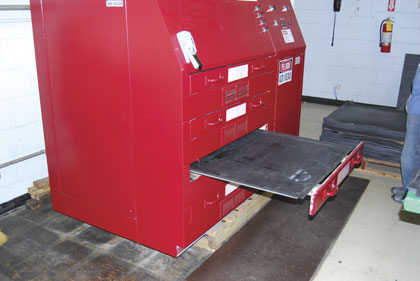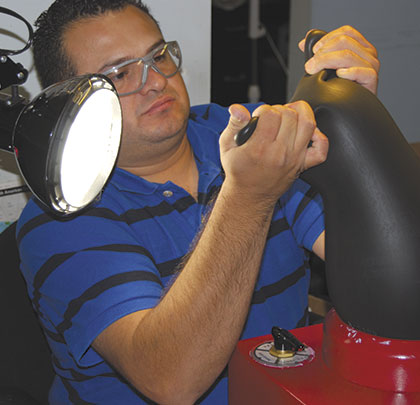OSHA rules and NFPA standards make the use of rubber insulating products mandatory when even the smallest probability of contact with 50 volts AC or higher exists. These rules affect nearly all industrial workplaces, as every single facility (including utility contractors and general contractors) has a need for electrical safety and arc flash protection, and failure to comply can result in heavy fines, serious injury, and even death. Moreover, OSHA and ASTM standards also require regular inspection and testing of in-service electrical protective equipment in order to maintain compliance and ensure the products’ safety and integrity when exposed to a wide range of voltages. Fortunately, there are safety measures and solutions that you can easily employ to help prevent injuries, citations, and penalties, including visual inspection and electrical testing.
RUBBER GOODS VISUAL INSPECTION
Rubber insulating products must be inspected before each use. Common problems to look for include the following:
- Cracking and cutting: Prolonged folding or compressing can cause this type of rubber damage.
- UV checking: Storing in areas exposed to prolonged sunlight causes UV checking.
- Chemical attack: Oils and petroleum compounds can cause swelling of the rubber.
- Avoid folding: The strain on rubber at a folded point is equal to stretching the rubber to twice its length.
- Snags: Wood, metal splinters, and other sharp objects can snag or tear rubber.
- Physical damage: Rope burns, deep cuts, and puncture hazards are cause for rejection.
INSULATING RUBBER GLOVE AND SLEEVE CARE
Visually inspecting rubber gloves and sleeves identifies physical, chemical, or ozone damage. Direct light is recommended because it enhances the ability to see surface imperfections on the rubber. Inflating the gloves with air or otherwise stretching the surface helps identify age and ozone damage, as well as other physical damage such as cuts, snags, abrasions, or tears.
Expand gloves no more than 1.5 times their normal size for Type I rubber and 1.25 times normal for Type II rubber. Listen for escaping air to detect holes. If a portable inflator is not available, use a rubber glove inspection tool or roll the glove cuff tightly to trap air inside, then apply pressure to areas of the glove to inspect for escaping air. Repeat the procedure again with the rubber gloves turned inside out.
When inspecting rubber sleeves, make sure to examine them along the edge as they are rolled. Rolling will stretch the sleeve along the edge, making cuts, tears, and ozone cutting more visible. Repeat this process again with the rubber sleeve turned inside out.

Featured Image: Visual glove inspection.
Above: Blanket electrical testing.
INSULATING RUBBER BLANKET CARE
Roll rubber insulating blankets to properly inspect them in order to locate scratches, tears, abrasions, snags, corona cutting, or age cracking. Make sure to roll the blankets two times on each side, with the second roll at a right angle to the first. Immediately remove blankets from service that show any signs of damage.

Glove electrical testing.
INSULATING RUBBER LINE HOSE CARE
Make certain to thoroughly inspect rubber insulating line hose, hoods, and covers inside and out for cuts, scratches, corona cutting, holes, tears and punctures, aging, rope or wire burns, and texture changes, such as swelling, softening, hardening, becoming sticky or inelastic.
ELECTRICAL TESTING
After the visual inspection is completed, electrically test the rubber goods at their rated test voltage using specialized equipment designed to gradually increase the voltage to the desired test level. The dielectric test is two-fold: pass/fail on the ability to withstand the rated test voltage and, for gloves, quantitative on the ability to prevent electric current from passing through the rubber goods above the maximum contained in the specifications. Products passing the inspection and test procedures can then be returned to service.
Testing is a critical component to electrical safety in that it helps maintain compliance and it also helps increase savings. ASTM F478 (insulating line hose and covers), ASTM F479 (insulating blankets), and ASTM F496 (insulating gloves and sleeves) specifications apply to the in-service care of rubber insulating products. Rubber insulating products are costly and many times these costs are unnecessarily increased by purchasing replacements for products that could have remained in service with the proper testing and recertification.
If you do not have the equipment required to perform these electrical tests, there are independent testing facilities that can perform the acceptance and in-service testing on behalf of end users.
TESTING FACILITIES
When selecting a test lab for use, make sure that it is a NAIL-accredited test lab. NAIL stands for National Association of Independent Laboratories for Protective Equipment Testing (www.nail4pet.org). It incorporates the only Laboratory Accreditation for the electrical equipment test labs program in North America. NAIL4PET helps develop uniformity in testing and works in close association with the American Society of Testing Materials (ASTM International).
The interval between the date of issue and electrical testing should be based on work practices and test experience. For gloves, the interval shall not exceed 6 months except for industries such as telecommunications that utilize insulating gloves as precautionary protection, in which case the maximum interval may be increased to 9 months. For sleeves and blankets, the interval shall not exceed 12 months. For line hose and covers, no minimal maximum interval is specified; electrical testing should be performed if the periodic cleaning and visual inspection identifies conditions that might adversely affect performance and safety. Keep in mind that all electrical protective rubber insulating products are tested by the manufacturer prior to the first shipment. End users (or an end users’ designee) may perform acceptance testing within the first 2 months after receipt. However, do not place rubber insulating products into service unless they have been tested electrically within the previous 12 months.
With so many workers using rubber insulating equipment and so many testing interval variables to consider, it is easy to see how compliance can fall through the cracks. Consider partnering with an electrical test lab that can test your rubber goods AND manage the rubber goods change-out process for you. ■
About the Author: Richard A. Rivkin is president and chief executive officer of Saf-T-Gard International, Inc., a privately held, family owned and operated global supplier of industrial safety products based in Northbrook, Illinois. Founded in 1936 as Latex Glove Company, Saf-T-Gard carries on the tradition that was started more than 80 years ago: bringing customers the products, training, and service they need to keep employees safe in the workplace. To learn more, visit www.saftgard.com, or call 800.548.GARD (4273).
_________________________________________________________________________
Modern Contractor Solutions – January 2016
Did you enjoy this article?
Subscribe to the FREE Digital Edition of Modern Contractor Solutions magazine.



